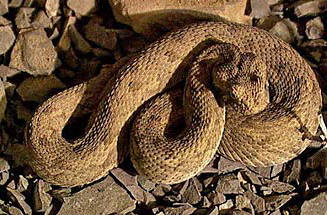|
Bitis inornata (Plain mountain adder, Hornless adder)
Ongemerkte bergadder [Afrikaans]; uNomondwana [Xhosa]
Life >
Eukaryotes
>
Opisthokonta >
Metazoa
(animals) > Bilateria > Deuterostomia >
Chordata >
Craniata > Vertebrata (vertebrates) > Gnathostomata (jawed vertebrates) >
Teleostomi (teleost fish) > Osteichthyes (bony fish) > Class:
Sarcopterygii (lobe-finned fish) > Stegocephalia (terrestrial vertebrates) >
Tetrapoda
(four-legged vertebrates) > Reptiliomorpha > Amniota >
Reptilia (reptiles) >
Romeriida > Diapsida > Lepidosauromorpha > Lepidosauria >
Squamata > Serpentes
(snakes) > Family: Viperidae > Genus:
Bitis
 |
|
|
Bitis inornata (Plain Mountain adder, Hornless adder),
Eastern Cape [I. Scammel © from
SARCA
Virtual Museum] |
|
Identification
The Plain mountain adder can be identified by its reddish
brown colouration, between 19 and 24 dark blotches down the length of the body,
its keeled scales, its flat snout and a triangular head which is distinct from
the rest of the body. This snake reaches an average length of 30 cm but can
reach 35 cm in length.
Distribution and habitat
Distribution is confined to the Sneeuberg
mountains of the Eastern Cape (between Graaff-Reinet and Cradock).
Its favoured habitat is high mountain slopes (above the snow line) where it is
often found under rock slabs or in grass tussocks.
Food
Feeds mainly on lizards (particularly skinks and lacertids)
and occasionally small
mammals
(e.g.
rats and
mice).
Predators, parasites and disease
Unknown.
Reproduction
Viviparous (give birth to live young); five to eight offspring
are born in late summer.
Longevity
Average lifespan is between 5 and 10
years.
Medical importance
This snake's venom has not been studied but is likely to be
a weak cytotoxic venom causing pain, swelling and possibly necrosis. Antivenom
is not required.
Links
References
-
Broadley, D.G. 1983. FitzSimons' Snakes of Southern
Africa. Delta Books, Johannesburg.
-
Marais, J. 2004. A Complete Guide to Snakes of Southern Africa.
Struik Publishing, Cape Town.
|
